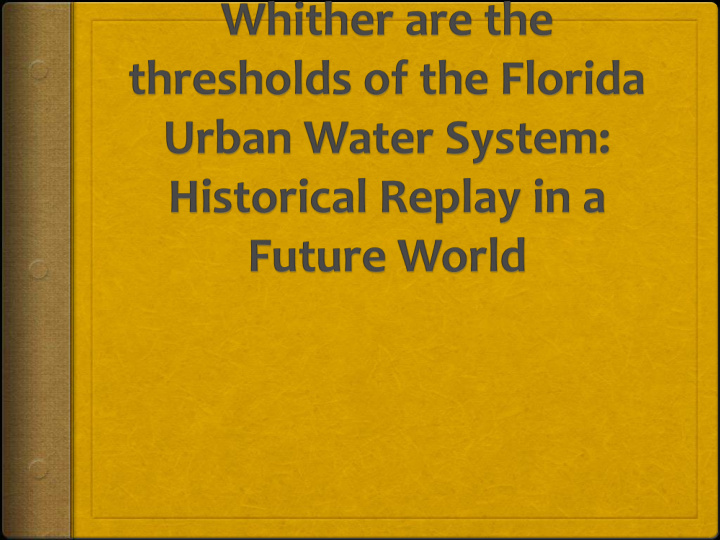



The Team so far…. Vasu Misra (FSU; Climate ) Chris Coutts (FSU, Urban planning/Demography) Tatiana Borisova (UF, Water Economics/Extension) Jane (USF, Integrated Supply/demand modeling at WMD level) Tirusew (TBW, Integrated Supply/demand modeling at Utilitiy level) Lisette (UF, coordinator/keep us on track with stakeholders) Mike, Kevin, Rob, Alison (Stakeholders who will define the problem for us )
Overarching hypothesis In a changing and varying climate, the Florida urban water supply and demand system is accelerating to reach “thresholds” of demand exceeding supply if the supply system remains unchanged under rapidly increasing population and changing demography. Ancillary hypothesis: At the aggregate level (management district level) climate variability and change may be the drivers for reaching thresholds faster. But at finer scales (Public water utility level) demography may be the drivers for reaching the thresholds faster. So in ignoring the changing climate at the WMD level, the urban water supply and demand system is being put in further strain.
Methodology We replay “historical events” in a future world of 2030, 2070, and 2100 Historical events will be defined by the stakeholders What are the thresholds? What is the uncertainty? What are the sources of the uncertainty?
FUTURE world: Changes in i. Sea level rise rates, ii. Wet season length decrease Temperature mean / variances iii. Extreme Events and iv. Aquifer level reductions te Human System (Water supply and Natural System (Surface and demand system) ground water hydrology) i) Water demand i) Aquifer levels / stream flows ii) Landuse Changes ii) Water quality and (Coastal/Inland) iii) Seasonality iii) Policies: water withdrawal and iv) Variance of weather and recovery, allocation climate (droughts, flooding, ts iv) Water suppliers: cost-recovery, etc.) conservation, and investments v) Sea level rise Water quality / runoff Water withdrawal rates Meteorology
Temperature is affected by land cover and land use
The impact of 3ft sea level rise
Sea surface Rainfall temp. The impact of strength and position of Gulf Stream: When Gulf Stream stronger and closer to coast, there is more rain in peninsular Florida.
Length of the wet season on an average is reducing by about 0.25 days/year in the last 60 years of data.
Climate Drivers
Missing links Ground water expert — sea water intrusion Hydrology: From Meteorology to flow in watershed Water quality Others?
Recommend
More recommend